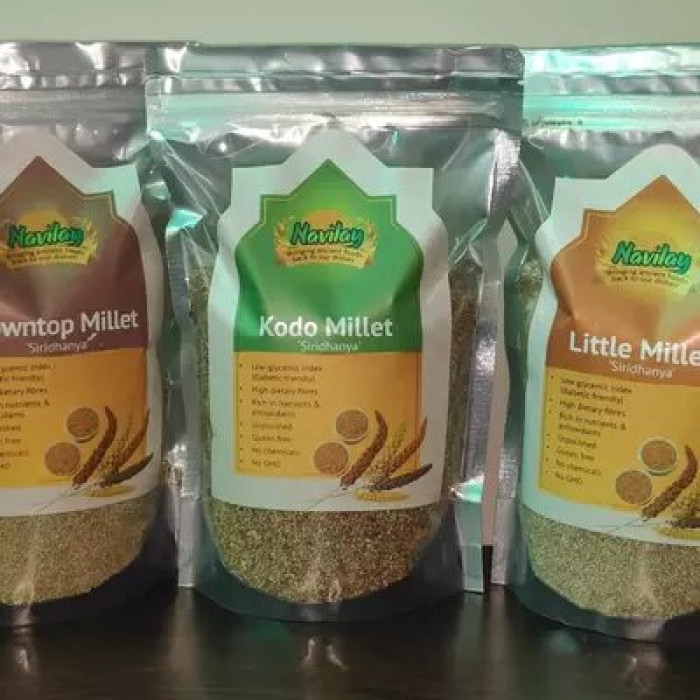
Living with diabetes requires careful attention to one's diet, with a focus on consuming low glycemic index foods that promote stable blood sugar levels. While traditional staples like rice and wheat may be off-limits for diabetics, the search for healthier alternatives has led to the rediscovery of Siridhanya millets. These ancient grains have gained popularity due to their numerous health benefits, particularly for individuals managing diabetes. In this article, we delve into the world of Siridhanya millets for diabetics, exploring their nutritional value, cooking methods, and addressing common questions about incorporating them into a diabetes-friendly diet.
Siridhanya Millets for Diabetics: A Nutritional Powerhouse
Siridhanya millets are gluten-free, high-fiber grains packed with essential nutrients that make them an excellent choice for individuals with diabetes. Let's take a closer look at why they are gaining recognition as a nutritional powerhouse:
1. Rich in Fiber and Low in Carbohydrates: Supporting Stable Blood Sugar Levels
Including Siridhanya millets in your diet can help maintain stable blood sugar levels due to their high fiber content and low glycemic index. Unlike refined grains, which can cause blood sugar spikes, the slow digestion and absorption of millets help prevent sudden glucose surges, providing a steady release of energy.
2. Abundant in Essential Nutrients: Boosting Overall Health
Siridhanya millets are a rich source of essential vitamins, minerals, and antioxidants, which contribute to overall well-being. These include magnesium, phosphorus, potassium, iron, and B-vitamins, which are vital for energy production, proper nerve function, and cardiovascular health.
3. Gluten-Free Alternative: Beneficial for Gluten Intolerant Individuals
For individuals with gluten intolerance or celiac disease, Siridhanya millets offer a safe and nutritious alternative to gluten-containing grains. Incorporating millets into the diet can help alleviate digestive discomfort and improve nutrient absorption.
4. Weight Management: Aiding in Healthy Weight Loss
Maintaining a healthy weight is crucial for managing diabetes effectively. The high fiber content in Siridhanya millets helps promote satiety, reducing cravings and aiding in weight management. Additionally, the complex carbohydrates present in millets are digested slowly, providing a prolonged feeling of fullness.
Cooking and Incorporating Siridhanya Millets into Your Diet
Now that we understand the benefits of Siridhanya millets for diabetics, let's explore various cooking methods and ways to incorporate these nutrient-rich grains into your daily meals:
1. Cooking Methods for Siridhanya Millets
Siridhanya millets can be cooked in a variety of ways, offering versatility and adding exciting flavors to your meals. Here are some popular cooking methods:
- Boiling: Boil millets with water or vegetable broth to prepare a fluffy and nutritious base for salads, stir-fries, or side dishes.
- Roasting: Dry roast millets in a pan before cooking to enhance their nutty flavor and add a delightful crunch to dishes.
- Pressure Cooking: Utilize a pressure cooker for quick and efficient millet preparation, saving time while retaining their nutritional value.
We invite you to read our complete guide to Siridhanya millets for those suffering from diabetes. If you or someone in your family suffers from diabetes, you are aware of how important it is to control those blood sugars in a way that is effective. Recently there has been a growing interest in the use of alternatives to cereals and grains such as Siridhanya milllets for managing diabetes. The following article we'll look into the realm of Siridhanya millets, looking at their nutritional benefits, their effects upon blood sugar levels in addition to how they could be integrated into a diet that is diabetic-friendly.
Understanding Diabetes
Before we look into the advantages that come from Siridhanya millets, we need to be aware of diabetes. It is a chronic disease which is defined by elevated blood sugar levels. There are two forms of diabetes one being type 1 and the other type 2.
Type 1 Diabetes This kind of diabetes is usually diagnosed in early adulthood or childhood and is caused by the body's is unable to make insulin. It is an hormone which helps regulate blood sugar levels.
Type 2 Diabetes Type 2 Diabetes: This kind of diabetes is more prevalent and typically is found later in the course of. In the case of type 2 diabetes the body doesn't make enough insulin or is intolerant towards its consequences, which leads to a rise in level of blood sugar.
The management of diabetes is a mix of factors that include treatment, lifestyle changes and diet choices. This is the point at which Siridhanya millets enter the picture.
What Are Siridhanya Millets?
Siridhanya millets comprise a variety of grasses with small seeds that have been grown and eaten for centuries across different regions of the globe. They are frequently referred to as "ancient grains" due to their importance in the past and the health benefits. They are gluten-free, which makes them a good option for individuals who suffer from celiac disease or gluten sensitivities.
There are many kinds of Siridhanya millets, which include:
Foxtail Millet (Thinai): Foxtail millet is abundant in dietary fiber proteins, minerals, and dietary fiber. It has a distinct nutty flavor and a soft texture making it a great ingredient that can be used in sweet as well as food items.
Pearl Millet (Kambu): Pearl millet is renowned for its iron content as well as its excellent nutritional profile. It has a mildly sweet taste and a couscous-like texture, which makes it a favorite ingredient for porridges, bread and Rotis.
The Finger Millet (Ragi): Finger millet is an excellent source of nutrients, which includes calcium iron, calcium amino acids, and calcium. It has a distinctive earthy taste and is often used in the preparation of porridges, dosas and baked goods.
Barnyard Millet (Kuthiravali): Barnyard millet is an excellent source of diet fiber as well as essential minerals. It is a light taste and a grainy texture making it ideal for pilafs, umas, and Idlis.
Little Millet (Samai): Little millet is a great source of antioxidants, fiber, as well as B vitamins. It has a light sweet, nutty taste and can be found in a wide variety of recipes, such as pulao, Kheer, and salads.
Siridhanya Millets and Blood Sugar Control
One of the primary reasons Siridhanya millets have attracted recognition in those with diabetes is the capacity to aid in managing blood sugar levels efficiently. In contrast to refined grains that can trigger sudden spikes in blood sugar levels, Siridhanya millets have a low glycemic Index (GI). The glycemic index is a measure of the speed at which a food increases glucose levels in the blood.














